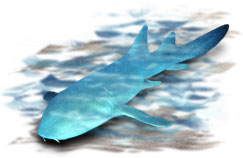What Are My Chances of an Attack?
In the U.S., your chances of getting killed by lightning are 30 times greater than dying of a shark attack. Bees, wasps, and snakes kill more people each year than sharks. Drowning, heart attacks, beach accidents resulting in spinal injury, sunburn, cuts from stepping on sea shells, dehydration, jellyfish stings, and traffic accidents going to or from the beach are all far more common than shark attacks. Between 1990 and 2009, there were 15,011 bicycle fatalities, compared with only 14 deaths due to shark attack. In 2009 alone, there were 630 deaths due to bicycles and 1 shark-related fatality. Between 1985 and 2010, there were 1,602 tornadoes in the state of Florida, which resulted in 125 deaths. Florida waters witnessed 484 shark attacks and 6 fatalities. Between 1990 and 2006, 16 people died as a result of sand hole collapse, while 11 fatalities were attributed to shark attacks during the same time period.
Sharks are not bloodthirsty maniacal killers. As the ocean’s number one predator, sharks help maintain the balance of nature by reducing animal populations.
Six Deaths in 2015
Considering that tens of thousands of people come in close contact with sharks each year while swimming, surfing, or boating, the number of shark attacks is negligible. In 2015, while there were 98 confirmed “unprovoked” shark attacks—surpassing the previous high of 88 in 2000—in the world, there were actually fewer deaths: 6 deaths in 2015 compared with 11 deaths in 2000.
Inaccurate Statistics
The actual number of attacks is hard to determine because of poor reporting in many areas. News about shark attacks is often supressed so tourists will not be driven away. Most shark attacks occur on the inshore side of a sandbar or between sandbars because fish congregate there and because sharks can become trapped at low tide. Sharp drop-offs also attract lots of fish and, therefore, sharks.
Hit and Run
The most common type of attack is the so-called “hit and run” assault. The shark bites and then quickly releases the person and disappears. These attacks usually involve injuries to the leg below the knee and are not usually fatal. Humans are usually considered too bony to be a good meal for a shark. Hit-and-run attacks are probably most often cases of mistaken identity. They usually happen near the surface and in poor visibility. Breaking surf, heavy currents, and other factors may make it hard for the shark to see its victim clearly.
Surfboards and Seals
Seen from below, swimmers or surfboarders are often mistaken for seals or sea lions, whose fatty bodies are a favorite treat for sharks. Human splashing creates irregular ripples in the water below, which to a shark may indicate an injured seal or fish, that likely be an easy meal.
“Fishy Jewelry”
Shiny jewelry that gleams like fish scales, multi-color swimsuits, and irregular tanning, especially on the bottom of the feet, could also confuse a shark into thinking a person was an animal. In some hit-and-run attacks, sharks could be displaying dominance behavior, perhaps warning a human that it is intruding in its territory. When attacks are reported, it is often difficult to determine what type of shark was involved since even experts can have trouble distinguishing them when in the water. In Florida waters, black tip, black nose, and spinner sharks are probably responsible for most of the hit-and-run attacks. “Bump and bite” and sneak attacks are much more rare and more apt to result in serious injury or fatality. These incidents usually take place in deeper water and are not believed to be cases of mistaken identity. Rather, sharks are angry or want to eat. Most attacks involving sea disasters, such as a plane crash or a shipwreck, fall into the bump-and-bite or sneak categories. In bump-and-bite attacks, the shark circles its victim then bumps into it before attacking. Sneak attacks occur without warning. Often, these attacks are repeated several times.
Fearsome Great White Shark
White, tiger, and bull sharks are believed responsible for most bump-and-bite and sneak attacks on humans. These are the largest species that eat human-size prey, including marine mammals, sea turtles, and large fish. Other species believe to have attacked in this manner, but more rarely, include the hammerhead, short fin mako, oceanic whitetip, Galapagos, and some reef sharks such as the Caribbean. Gray reef, lemon, dusky, blue, sand tiger, nurse, and Ganges River sharks will also attack humans. Still, of the more than 375 species in the world only about 30 have ever been reported to even have attacked humans. In fact the largest species, the whale and basking sharks, eat only plankton. Even so, experts warn that any shark six feet long or more is large and powerful enough to kill a person and should be treated with caution. Provoked attacks are most common when a person touches a shark, including helping untangle it from fishing nets. Divers who touch or feed a shark risk attack.
Tips for Avoiding Attack
Stay out of the water at night, dusk, or dawn. Sharks are most active at night. Swim in a group. Sharks prefer to attack lone victims. Keep close to shore. It will be easier for help to reach you in an attack. Avoid sandbars and sharp drop-offs where fish congregate. Stay out of polluted or murky water. Avoid areas being used by fishermen. Be wary of feeding birds, or porpoises, which indicate the presence of fish. Do not swim if you are bleeding. Sharks can detect tiny amounts of blood. Do not wear shiny jewelry; underwater it resembles fish scales. Avoid bright swimsuits and uneven tanning. Contrasts attract sharks. Do not splash a lot, since it attracts sharks. Keep pets out of the water. Erratic movements attract sharks. Never try to touch any type of shark.
*Statistics are from the International Shark Attack File, maintained by the Florida Museum of Natural History at the University of Florida, Gainesville, and the American Elasmobranch Society.
